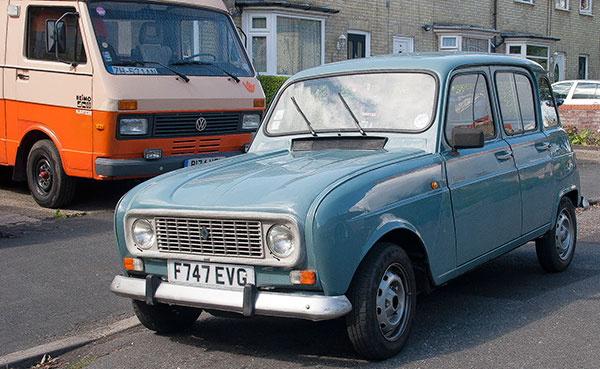Why did I want to buy a Renault 4? In January 2014 I was sitting in a cafe in Montmartre during the winter Paris classic car tour Vincennes en Anciennes watching the normal selection of old Citroen 2CVs and Dianes, Fiat 500s, obscure Italian sports cars and a variety of old British classics driving through the square, I wanted something that was different but still cool but I didn’t know what that was. I took a photo of a Citroen Diane which I really liked but couldn’t get away from the memory of driving to London in the early 80s, screaming down the motorway in a 2CV holding on to the roof, wasn’t much fun, I also have a soft top buggy so I wanted something with a solid roof!
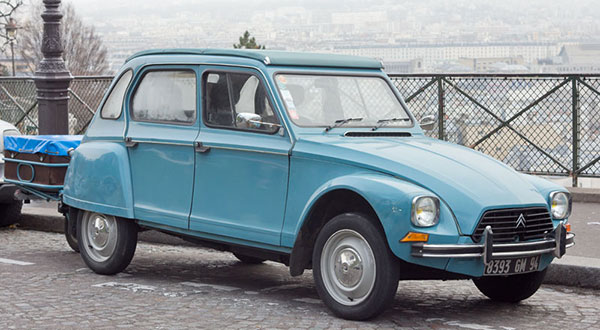
I also decided that I wanted something useable, not just an occasional car, something I could use everyday that was practical, robust and fun. Eventually I decided that car was a Renault 4. The Renault 4 seemed basic enough, something that could be repaired with a few basic tools, simple design, agricultural engineering and not to fussy.
There didn’t appear to be very many for sale in the UK, most of what I came across on the internet where either to far gone for sensible repair or owned by enthusiasts who seemed to be trying to hard. Eventually I found one that was reasonable local and described on a Renault 4 website as a ‘Classic French Car’, there where lots of pictures of the car during it’s ‘restoration’ and it was now for sale. I made arrangements to see the white Renault 4 and went off to see it. I have been involved with VWs for about 30 years now and have seen the scene grow from the 1980s minority interest to what it is today, I wasn’t prepared for the Renault 4 world at all and found that it attracts some rather odd people, the owner of the white Renault 4 was the first….
I arrived to look over the car, it all looked good from the outside, not to bad for a mid 80s car, typical random coloured fluffy seat covers on the inside etc. The seller was apparently a Renault 4 expert with a website so I was in luck. I had a look underneath to see the condition of the floor, it had been welded with strange shaped plates here and there, probably gasless mig welding, the spatter was everywhere and the job clearly not done very well, the plates where not painted and had take on a lovely brown rust colour. The engine sounded OK and looked clean enough but after about 10 minutes running on idle as we discussed the price I noticed that there was a steady stream of oil coming from around the rocker cover, the expert told me that ‘they all did that’ to which I replied ‘surely they only do that when there is something wrong?’, this is when the seller seemed to take offence at my identification of the ‘bad points’ and decided that the car was not for me. I was happy with that, an oily rusty car for good money is not what I was after, I went home.
I know a thing or two about buying and importing cars from Germany, the T25 that I have talked about in the past came from Karlsrhue and the three day train and road trip to get it was a great caper so I took a look in Germany. I found a chap called Chris in Freiburg im Breisgau, a city that I know quite well and I though I knew where his car lot was. He had a large selection of Renault 4s from France all for sale. I kept an eye on the listings he had and made a plan to visit in August to take a look.
While looking for a car I found one car that came up a for sale a few times, once in Norfolk, then South Wales then Burnham on Crouch. I had had a chat with the seller of the car when it was in South Wales but decided he wanted more for the car than it was worth, I had a number of pictures of the car and though that is was structurally OK but probably need some minor cosmetic work. It eventually came up for sale again in late July shortly before I was going to Germany, it turns out a German bloke had bought it from South Wales and decided it was not for him.. more on that later…
In August I visited the car lot in Freiburg to look at the Renault 4s, I had decided that I would buy one if there was one that was solid and sound enough for me to drive to the UK on export plates. There where some great looking cars, a 1970s chrome bumper model was very nice but all far to expensive, some around 10000 euros. I decided to try and buy the car I had seen for sale in the UK, so while in Freiburg I made contact, arranged a price and a day to view and collect the car from Essex.
Later I found that he had takes some pictures of me looking at the cars, this one I found on his web site.
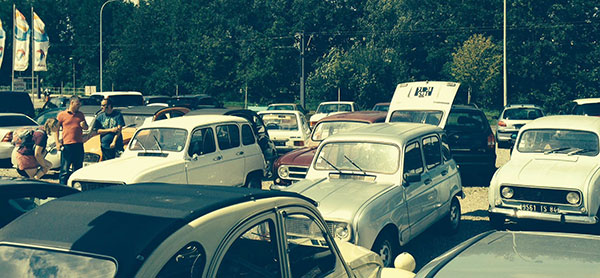
The day for the trip to Burnham on Crouch came and I set off with a one way ticket and a pocket full of money. When I arrived at the station I saw the car waiting for me, it looked exactly as I had hoped and I recognised the car from the other times I had seen it for sale, the pictures I had of the car where good and the car was as good as I had hoped. We went for a drive in the car and it was clear that it was structurally sound but there was something odd with the mechanical side, it rattled everywhere and was running quite poorly, starved of fuel I though. Looking over the paperwork I was satisifed that everything was OK, French and UK paperwork seemed in order but there was no MOT certificate, we checked online and it had 11 months MOT, so I decided to buy it and drive it home, just as well as I had already insured it. While inspecting the car it was clear that the was something wrong with the issuing of the MOT certificate, apparently no advisory notices on the MOT. I am not an MOT tested but I don’t think one bald tyre, one missing windscreen wiper, the lack of rear brakes and only one working headlight are grounds for passing a test, clearly a dodgy MOT.
The drive back to Cambridge was great fun, wonky steering, lack of power unless at full throttle and the rattling sounds from all over, but really good fun, what a crazy car and just what I wanted. On the trip I made the decision that I would drive the car for a month before doing anything to it, just to see if it kept going and find out what was going to fall off. During the month I made an exhaustive list of all of the work that I needed to do to make the car as good as it could be, anyone who knows my other cars knows how well maintained they are, they are not all shiny and perfect but they are mechanically excellent and so far totally reliable as a result. The list went on and on, five new tyres, four new shock absorbers, new disks and pads, new shoes and wheel cylinders, new read wheel bearings, new front upper wishbones, new windscreen wipers, replacement front indicator / sidelight holders, new headlamps, new water pump, new exhaust, new fuel pump, carb repair kit etc. etc. I spent hours looking for new old stock parts on Ebay from all over Europe and a steady stream of parts arrived for bargain prices. I set about fitting all the parts.
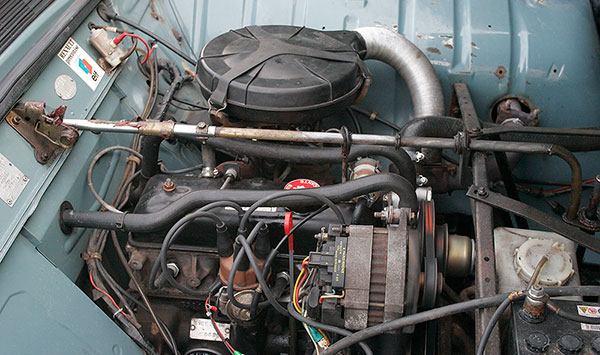
Before I bought the car I had though that I would use some local classic car and specialist Renault garages to do some of the work that I didn’t have time to do, so the first job for the local classic car garage was to fit a pair of new Firestone tyres to the back of the car, investigate the torsion bar rattle on the right side of the car and, as they have a ramp, inspect and replace where necessary the lower wishbone bushes and find out why it was running poorly. This is where the real classic car garage comes into it’s own, experts doing expert jobs. Alas, not this classic car garage, they failed to find the problem with the torsion bar, they failed to fix the play in the lower wishbone bush and only found lesser branded tyres. It appears from the cars in their garage that they only change lightbulbs on Triumphs. I moved on.
A month or so later it was snowing, I decided to ask a local Renault specialist to source and replace the rear brakes as I had not had time to remove and inspect them to find the problem, perhaps they could look at the torsion bar probles too, I had sorted out the front wishbone problems myself. After a week in the specialist garage they couldn’t identify the rear brake shoe manufacturer and could see no problems with the torsion bar. I asked for a picture of the brake shoes, obvious what they where to me as soon as I saw them and I ordered a new kit from Lyon, arrived in two days. I collected the car and we fitted the brake parts, job done. So much for the local experts.
Over the winter I fitted all the parts I had sources myself, the waterpump was a bit of a problem and I had to find a thermostat with the correct temperature. The hardest part to find was the full lenght single section exhaust, none of the UK suppliers had one, I found one in Germany and one in France but the shipping was impossible, the package was to long. I planned a trip to Le Touquet for a few days to get an exhaust but before I booked the crossing I managed to find a full lenght exhaust in the UK by using the OEM part number, it was listed on Amazon for £19.99 including delivery, it arrived next day in a 9 foot box!
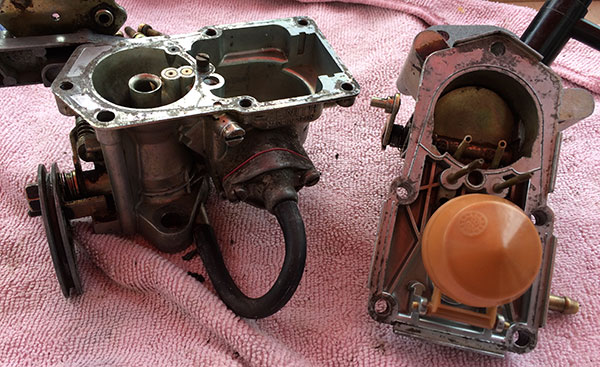
I solved the problems with the poor running by refurbishng the carbureta with a 15 euro kit from Germany that I fitted in about an hour, then adjusted the mixture and timing by ear, no need for any expensive kit, when it sounds right, it’s right.
In May I took the car to my local garage for it’s MOT, I was sure it would be fine and it was, it passed with no advisories at all, I was very happy with that, all the cars I considered stated that they that had ‘passed with flying colours’ or ‘flown through the MOT’, all rubbish, a car passes or fails the MOT and mine had passed, only passed and the emissions where in the normal range.
A couple of weeks ago while trying to work out how best to remove the front torsion bars without personal damage I came across a French Renault 4 workshop manual that had a description of the process, my loose translation of the bit about rebuilding the suspension after servicing it was that you should ‘take care to replace the rubber collars on the torsion bars as they could not be fitted when the bars where installed in the car’ (basic French to English). Rubber Collars? I couldn’t immediately see those on my car in the same place as the ones on the line drawing in the manual… I found that the ones on my car had worked their way to the very front of the torsion bars and where up agains the anti roll bar. Some further lying down under the car, looking and measuring I decided that the passenger side of the car had a slight dip in the floor pan, just enough to cause the torsion bar to come into contact with it during normal driving, in fact there was some minor wear on the floor pan as a result and it was quite shiny. I cleaned the torsion bars up a little with some WD40 and found I could slide the rubbers back to the correct position but the floor was causing the rubbers to get squashed. I got a few bits of timber and made a yoke around the torsion bar, lifted the car with a trolley jack with my dad keeping a close eye on the floor pan, at what seemed like a great height there was a loud pop and the floor pan went back into shape, I let the car back down and took a look at the torsion bar, there was enough clearance and I could secure the rubber collar in position.
Now when driving down the road the sounds of that Salvation Army playing tambourines in the passenger seat are a thing of the past.
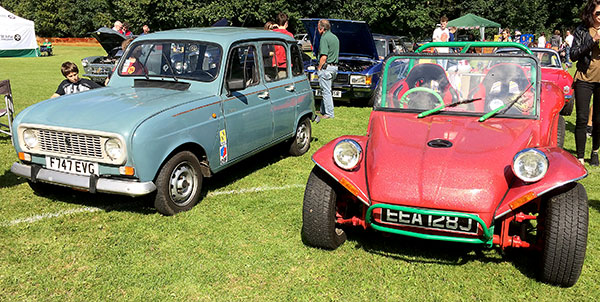
For anyone considering a Renault 4, you will find a ready supply of ‘new old stock’ parts on Ebay both in the UK and elsewhere in Europe for very little money. My advise is not to read any of the Renault 4 forums, they are all full of the normal enthusiasts who will always tell you you are doing it wrong and their way is the only way. It seems that everywhere you go someone will want to talk to you about the car, they had one, their parents had one, their geography teacher had one, they learned to drive in one, so much to talk about, I took the Renault and the VW Buggy to a show a couple of weeks ago, plenty of interest in both and lots to talk about.
Enjoy.







